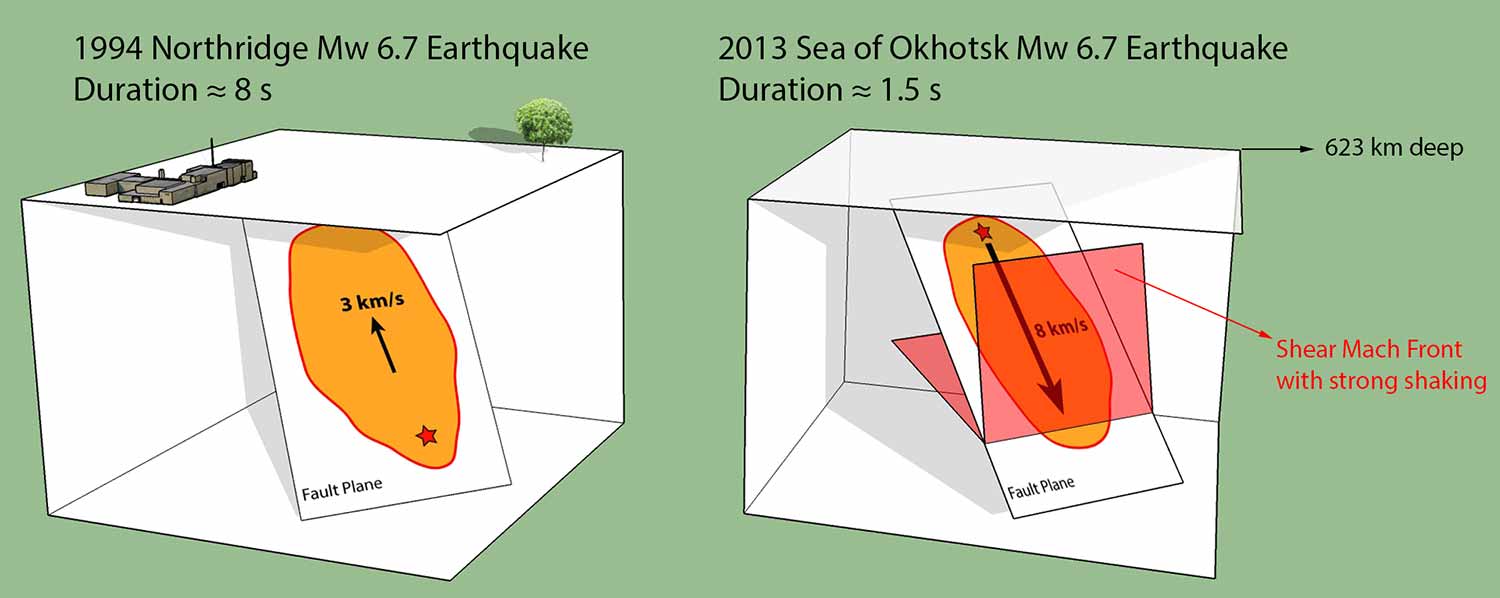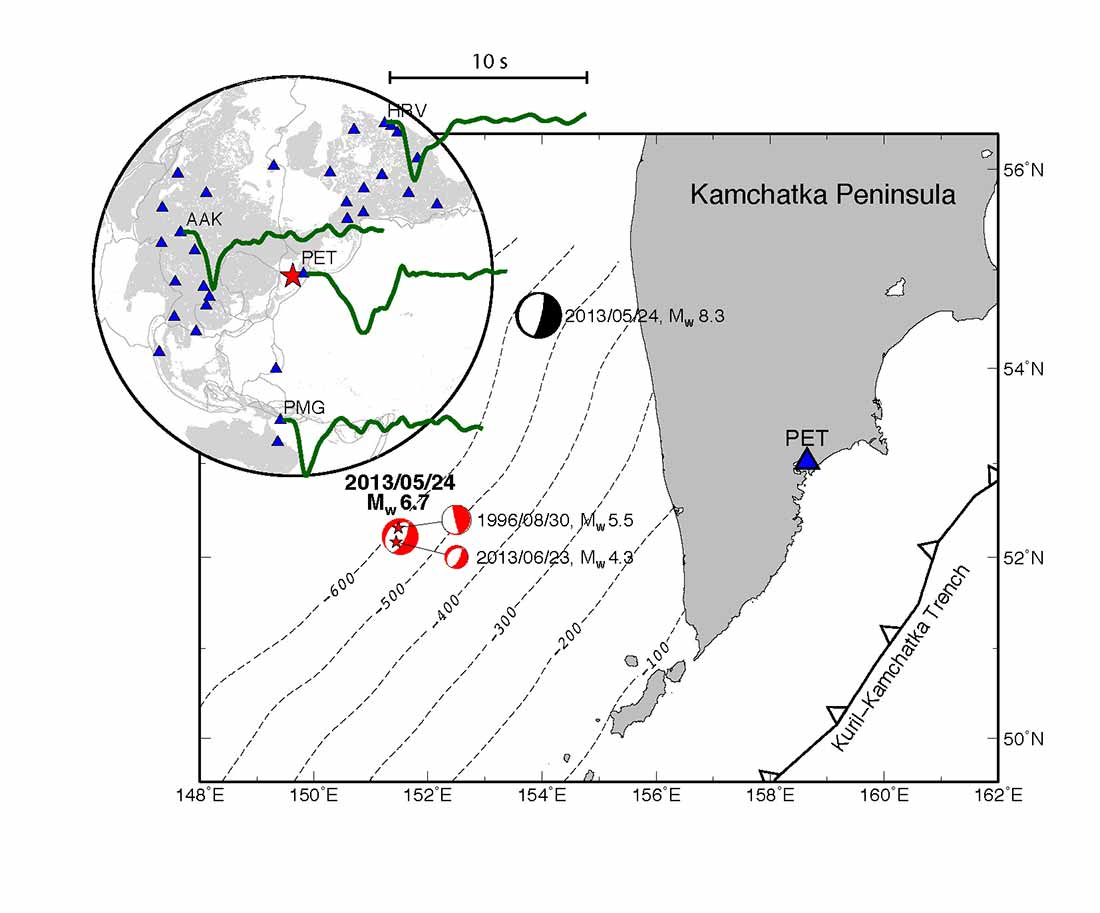Scripps Scientists Discover Evidence of Super-fast Deep Earthquake
Rare high-speed rupture off Russia provides clues about similar phenomena on shallow fault zones near Earth’s surface
Published Date
By:
- Mario Aguilera
Share This:
Article Content

The supershear 2013 Sea of Okhotsk earthquake had similar magnitude and fault geometry as the damaging 1994 Northridge earthquake in California, but a much larger depth and faster rupture speed. The high rupture speed (approximately 8 kilometers per second, or 18,000 miles per hour) away from the hypocenter, shown as the red star, concentrates strong shaking on the "Mach front."
As scientists learn more about earthquakes that rupture at fault zones near the planet’s surface—and the mechanisms that trigger them—an even more intriguing earthquake mystery lies deeper in the planet.
Scientists at Scripps Institution of Oceanography at UC San Diego have discovered the first evidence that deep earthquakes, those breaking at more than 400 kilometers (250 miles) below Earth’s surface, can rupture much faster than ordinary earthquakes. The finding gives seismologists new clues about the forces behind deep earthquakes as well as fast-breaking earthquakes that strike near the surface.

Red stars pinpoint the location of the 8.3 mainshock and 6.7 aftershock off the Kamchatka Peninsula.
Seismologists have documented a handful of these events, in which an earthquake’s rupture travels faster than the shear waves of seismic energy that it radiates. These “supershear” earthquakes have rupture speeds of four kilometers per second (an astonishing 9,000 miles per hour) or more.

Zhongwen Zhan, a postdoctoral researcher at Scripps Institution of Oceanography, UC San Diego
In a National Science Foundation-funded study reported in the June 11, 2014, issue of the journal Science, Scripps geophysicists Zhongwen Zhan and Peter Shearer of Scripps, along with their colleagues at Caltech, discovered the first deep supershear earthquake while examining the aftershocks of a magnitude 8.3 earthquake on May 24, 2013, in the Sea of Okhotsk off the Russian mainland.

Peter Shearer, professor of geophysics, Scripps Institution of Oceanography, UC San Diego
Details of a magnitude 6.7 aftershock of the event captured Zhan’s attention. Analyzing data from the IRIS (Incorporated Research Institutions for Seismology) consortium, which coordinates a global network of seismological instruments, Zhan noted that most seismometers around the world yielded similar records, all suggesting an anomalously short duration for a magnitude 6.7 earthquake.
Data from one seismometer, however, stationed closest to the event in Russia’s Kamchatka Peninsula, told a different story with intriguing details.
After closely analyzing the data, Zhan not only found that the aftershock ruptured extremely deeply at 640 kilometers (400 miles) below the earth’s surface, but its rupture velocity was extraordinary—about eight kilometers per second (five miles per second), nearly 50 percent faster than the shear wave velocity at that depth.
“For a 6.7 earthquake you would expect a duration of seven to eight seconds, but this one lasted just two seconds,” said Shearer, a geophysics professor in the Cecil H. and Ida M. Green Institute of Geophysics and Planetary Physics (IGPP) at Scripps. “This is the first definitive example of supershear rupture for a deep earthquake since previously supershear ruptures have been documented only for shallow earthquakes.”
“This finding will help us understand why deep earthquakes happen,” said Zhan. “One quarter of earthquakes occur at large depths, and some of these can be pretty big, but we still don’t understand why they happen. So this earthquake provides a new observation for deep earthquakes and high-rupture speeds.”
Zhan also believes the new information will be useful in examining ultra-fast earthquakes and their potential for impacting fault zones near the earth’s surface. Although not of supershear caliber, California’s destructive 1994 Northridge earthquake had a comparable size and geometry to that of the 6.7 Sea of Okhotsk aftershock.
“If a shallow earthquake such as Northridge goes supershear, it could cause even more shaking and possibly more damage,” said Zhan.
Coauthors of the paper include Donald Helmberger and Hiroo Kanamori of Caltech.
Note: Project IDA, based at Scripps-IGPP, operates nearly a third of IRIS’s Global Seismographic Network.
Share This:
You May Also Like
Engineers Take a Closer Look at How a Plant Virus Primes the Immune System to Fight Cancer
Technology & EngineeringStay in the Know
Keep up with all the latest from UC San Diego. Subscribe to the newsletter today.



